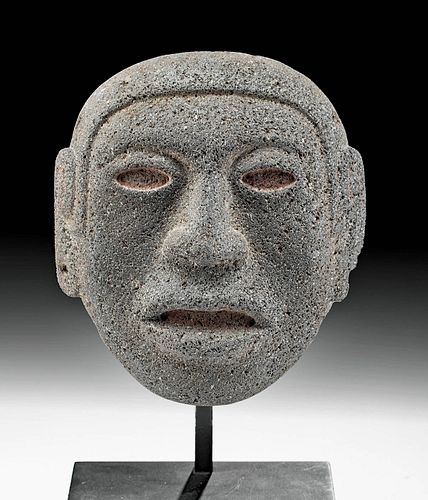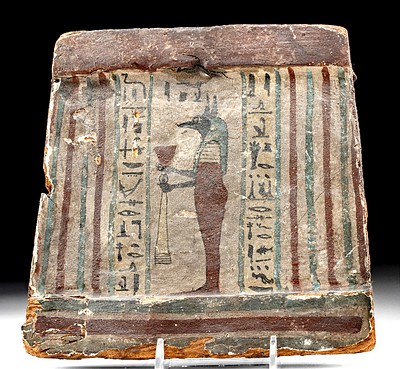Handsome Aztec Stone Face of Man
Lot 116
About Seller
Artemis Gallery
686 S Taylor Ave, Ste 106
Louisville, CO 80027
United States
Selling antiquities, ancient and ethnographic art online since 1993, Artemis Gallery specializes in Classical Antiquities (Egyptian, Greek, Roman, Near Eastern), Asian, Pre-Columbian, African / Tribal / Oceanographic art. Our extensive inventory includes pottery, stone, metal, wood, glass and textil...Read more
Estimate:
$16,000 - $24,000
Absentee vs Live bid
Two ways to bid:
- Leave a max absentee bid and the platform will bid on your behalf up to your maximum bid during the live auction.
- Bid live during the auction and your bids will be submitted real-time to the auctioneer.
Bid Increments
| Price | Bid Increment |
|---|---|
| $0 | $25 |
| $300 | $50 |
| $1,000 | $100 |
| $2,000 | $250 |
| $5,000 | $500 |
| $10,000 | $1,000 |
| $20,000 | $2,500 |
| $50,000 | $5,000 |
| $100,000 | $10,000 |
| $200,000 | $20,000 |
About Auction
By Artemis Gallery
Aug 26, 2021
Set Reminder
2021-08-26 10:00:00
2021-08-26 10:00:00
America/New_York
Bidsquare
Bidsquare : Fine Antiquities | Asian | Ethnographic Art
https://www.bidsquare.com/auctions/artemis-gallery/fine-antiquities-asian-ethnographic-art-7366
Features classical antiquities, ancient and ethnographic art from cultures encompassing the globe. Egyptian, Greek, Roman, Etruscan, Near Eastern, Asian, Pre-Columbian, Native American, African / Tribal, Oceanic, Spanish Colonial, Russian, Fine / Visual Arts, so much more! Artemis Gallery info@artemisgallery.com
Features classical antiquities, ancient and ethnographic art from cultures encompassing the globe. Egyptian, Greek, Roman, Etruscan, Near Eastern, Asian, Pre-Columbian, Native American, African / Tribal, Oceanic, Spanish Colonial, Russian, Fine / Visual Arts, so much more! Artemis Gallery info@artemisgallery.com
- Lot Description
Pre-Columbian, Central & Gulf Coast Mexico, Veracruz region, Aztec culture, Post Classic period, ca. 1200 to 1521 CE. A dramatic mask carved from a gray volcanic stone, the head of a young man with a trance-like expression. He presents a pronounced but naturalistic nose, slightly parted lips, shallow, almond-shaped eyes, large ears, and a low-cut coiffure. This plain hairstyle suggests that the head would have been furnished with different headdresses to represent various deities during festivals throughout the year. The earlobes and sides of the head are pierced with suspension holes. Notice that this mask does not possess actual eye holes for seeing through and red cinnabar is used to highlight the sockets. This was a common practice as stone masks were often created for displays during rituals, or in death as a death mask, rather than to be worn by a living person. However, this was probably not a death mask as the eyes are open. Instead, it may have represented a portrait of man. Size: 6" W x 7" H (15.2 cm x 17.8 cm); 10.75" H (27.3 cm) on included custom stand.
For a similar example please see the American Museum of Natural History, catalog number: 30 / 11847.
The Spaniards wrote of the Aztecs believing that stone quarried to be carved had magical properties and was alive, able to speak and prophecy. Aztec stone sculpture is a culmination of centuries of stone carving in Mesoamerica, and, using fragile volcanic stone, they were able to create remarkably detailed artworks. The Aztec were heavily influenced by Teotihuacan culture, and much of their art is inspired by these predecessors. Indeed, the Aztec excavated the Teotihuacan city and reused and embellished many of the objects they discovered. The Aztecs regarded the city of Teotihuacan as a mythical site where the gods once assembled.
This mask is likely a stylized representation of a macehualtin, a lower-class citizen. The macehualtin were farmers who could attain some social mobility through training as warriors and military achievement. In Aztec culture fertility and sexual ability were of great importance. It was essential to depict men as youthful to demonstrate their "imperial supremacy" as seen in this handsome example!
Provenance: private Santa Fe, New Mexico, USA collection; ex-private Allan Davis collection, Santa Fe, New Mexico, USA acquired in January 2004; ex-private New York, New York, USA collection; ex-Walter Dawson collection, Omaha, Nebraska, USA, acquired in the 1960s
All items legal to buy/sell under U.S. Statute covering cultural patrimony Code 2600, CHAPTER 14, and are guaranteed to be as described or your money back.
A Certificate of Authenticity will accompany all winning bids.
PLEASE NOTE: Due to recent increases of shipments being seized by Australian & German customs (even for items with pre-UNESCO provenance), we will no longer ship most antiquities and ancient Chinese art to Australia & Germany. For categories of items that are acceptable to ship to Australia or Germany, please contact us directly or work with your local customs brokerage firm.
Display stands not described as included/custom in the item description are for photography purposes only and will not be included with the item upon shipping.
#163735Old inventory label on verso. Loss to lower earlobe on right side, otherwise excellent condition. Nice remains of red pigment in eyes and mouth.Condition
- Shipping Info
-
All shipping is handled in-house for your convenience. Your invoice from Artemis Gallery will include shipping calculation instructions. If in doubt, please inquire BEFORE bidding for estimated shipping costs for individual items.
-
- Buyer's Premium



 EUR
EUR CAD
CAD AUD
AUD GBP
GBP MXN
MXN HKD
HKD CNY
CNY MYR
MYR SEK
SEK SGD
SGD CHF
CHF THB
THB













